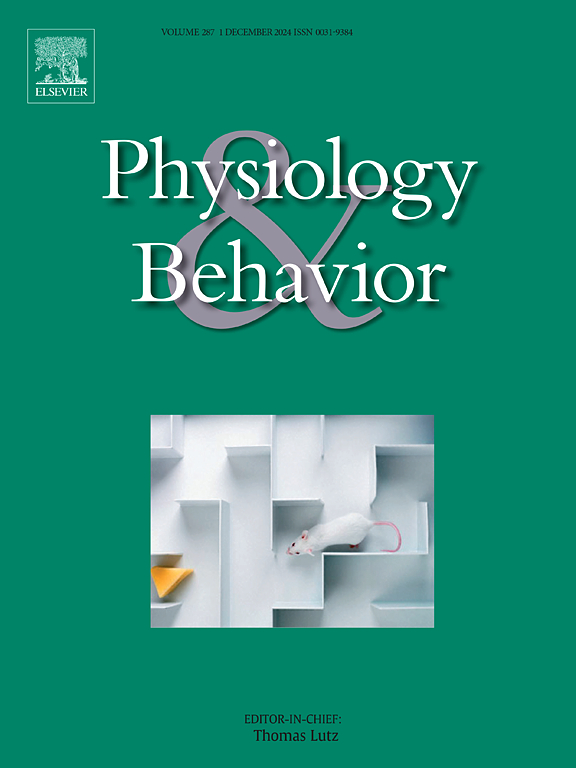Glial adaptations to high-fat diet in the mediobasal hypothalamus and effects on metabolic control
IF 2.5
3区 医学
Q2 BEHAVIORAL SCIENCES
引用次数: 0
Abstract
Obesity represents a global health issue and major socioeconomic burden. As a multifactorial disease, obesity is influenced by genetic and environmental factors, with maladaptive eating habits and high-fat, high-sugar diets (HFD, HFHS) overconsumption being major contributors. While traditionally studied in the context of adipose tissue and peripheral metabolism, the brain is at the centre of this pathology. In the central nervous system, circulating free fatty acids (FAs) are taken up directly, while brain lipoprotein lipases break down triglyceride-rich particles, providing an additional source of fatty acids. Growing evidence supports the idea that both neuronal and glial cells in the hypothalamus undergo significant changes in response to increased HFD consumption. These alterations may play a key role in the wide range of dysfunctions associated with obesity. The review at hand explores how FAs are utilised by the brain and how excessive intake of FAs during HFD feeding impacts glial cell function. We focus on glial cells within the mediobasal hypothalamus (MBH), one of the key brain subregions regulating energy balance. Microglia, the brain’s resident immune cells, are activated by HFD exposure, leading to morphological changes and inflammation in the hypothalamus, which likely contributes to neuronal dysfunction. Microglial depletion in the MBH can significantly limit HFD-induced metabolic alterations by reducing food intake, weight gain and brain inflammation. Astrocytes respond to HFD intake by utilising its nutrients for energy production. Unlike neurons, astrocytes actively perform β-oxidation and ketogenesis, which influence feeding behaviour. HFD-induced ketone production by hypothalamic astrocytes has been shown to acutely trigger an anorectic response in rats. Like microglia, they also undergo significant morphological changes and increase cytokine release in response to HFD, leading to altered synaptic and neurotransmitter regulation, which may in turn impair hypothalamic control of energy homeostasis. This review highlights the critical role of glial cells in mediating the effects of dietary FAs on brain function, emphasising their contribution to obesity-related neuroinflammation, hypothalamic dysfunction and energy balance.
下丘脑中基底神经胶质对高脂肪饮食的适应及其对代谢控制的影响。
肥胖是一个全球性的健康问题和主要的社会经济负担。肥胖是一种多因素疾病,受遗传和环境因素的影响,不适应的饮食习惯和高脂肪、高糖饮食(HFD, HFHS)的过度消费是主要原因。虽然传统上是在脂肪组织和外周代谢的背景下研究的,但大脑是这种病理学的中心。在中枢神经系统,循环游离脂肪酸(FAs)被直接吸收,而脑脂蛋白脂肪酶分解富含甘油三酯的颗粒,提供脂肪酸的额外来源。越来越多的证据支持这样一种观点,即下丘脑的神经元和神经胶质细胞在高脂肪摄入增加的情况下都会发生显著的变化。这些改变可能在与肥胖相关的各种功能障碍中发挥关键作用。这篇综述探讨了大脑是如何利用脂肪酸的,以及在高热量食物喂养过程中过量摄入脂肪酸是如何影响神经胶质细胞功能的。我们关注的是调节能量平衡的关键脑亚区之一——中基底下丘脑(MBH)内的胶质细胞。小胶质细胞,大脑的免疫细胞,被HFD激活,导致下丘脑的形态改变和炎症,这可能导致神经元功能障碍。MBH中的小胶质细胞耗损可以通过减少食物摄入、体重增加和脑部炎症来显著限制hfd诱导的代谢改变。星形胶质细胞通过利用其营养物质进行能量生产来响应HFD的摄入。与神经元不同,星形胶质细胞活跃地进行β氧化和生酮,从而影响摄食行为。hfd诱导的下丘脑星形胶质细胞产生酮已被证明可急性触发大鼠的厌食反应。与小胶质细胞一样,它们也会发生显著的形态变化,并在HFD的作用下增加细胞因子的释放,导致突触和神经递质调节的改变,这可能反过来损害下丘脑对能量稳态的控制。这篇综述强调了神经胶质细胞在介导膳食脂肪酸对脑功能的影响中的关键作用,强调了它们在肥胖相关的神经炎症、下丘脑功能障碍和能量平衡中的作用。
本文章由计算机程序翻译,如有差异,请以英文原文为准。
求助全文
约1分钟内获得全文
求助全文
来源期刊

Physiology & Behavior
医学-行为科学
CiteScore
5.70
自引率
3.40%
发文量
274
审稿时长
47 days
期刊介绍:
Physiology & Behavior is aimed at the causal physiological mechanisms of behavior and its modulation by environmental factors. The journal invites original reports in the broad area of behavioral and cognitive neuroscience, in which at least one variable is physiological and the primary emphasis and theoretical context are behavioral. The range of subjects includes behavioral neuroendocrinology, psychoneuroimmunology, learning and memory, ingestion, social behavior, and studies related to the mechanisms of psychopathology. Contemporary reviews and theoretical articles are welcomed and the Editors invite such proposals from interested authors.
 求助内容:
求助内容: 应助结果提醒方式:
应助结果提醒方式:


